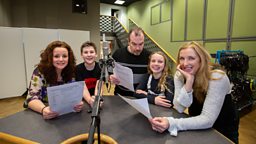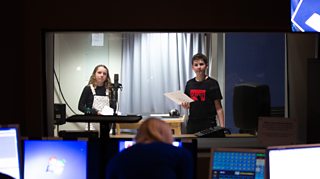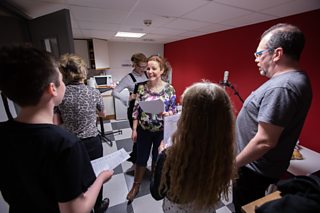WW2 Teacher's Notes - Scotland鈥檚 Home Front
Curriculum for Excellence information:
- Through art and design, learners have rich opportunities to be creative and to experience inspiration and enjoyment. EXA 2-02a, EXA 2-13a
- Learners should experience activities which enable them to develop the skills and attributes they will need if they are to achieve and sustain positive destinations beyond school. HWB 2-08a
- Our ability to use language lies at the centre of the development and expression of our emotions, our thinking, our learning and our sense of personal identity., LIT 2-02a, LIT 2-04a, LIT 2-05a, LIT 2-06a, LIT 2-10a / LIT 3-10a, LIT 2-15a, LIT 2-23a, LIT 2-24a
- Through social studies, children and young people develop their understanding of the world by learning about other people and their values, in different times, places and circumstances. SOC 2-01a, SOC 2-03a
- The technologies provide frequent opportunities for active learning in creative and work-related contexts.
- TCH 2-02a

Curricular area
- Literacy
- Listening and Talking
- Writing
Theme - Setting the scene
Activity
- Listen to opening:
- Prediction – What do you think is happening?
- What do you hear?
- How do these sounds make you feel?
- Play an air raid siren at a loud level - share and list feelings.

- Listen to the description from Tommy.
- List the sights that Tommy saw.
- Discuss emotions and feelings from Tommy.
- How would the children feel?
Curricular area
- Listening and talking
- Art
- Drama
- Problem solving
Theme - Air Raid Shelter
Activity
- How would it feel inside an air raid shelter?
- What did they see when they got out?
- How would they feel?
- Discuss and design a WW2 shelter
Children draw a bird’s eye view map of the inside of an air raid shelter. Discuss how they are going to make it comfortable? Remember to think about the resources available during the war. Once completed, children annotate the design to explain their reasons.
In groups, discuss and decide the safest and most effective shelter, create a mini model.
Following this, decide as a class a shelter that they can explore and use as a role-play area. If possible build this in an outdoor space. If this is not possible, have a role-play area inside the classroom that the children can build themselves.
Once the shelter is built, give the children time to experience inside the shelter and discuss how different it would feel during a bombing raid.
Allow the children the opportunity to respond to their experiences and feelings through the medium of art. Encourage the children to draw what it was like for them in the shelter, reflecting the dark, the cold, the damp and the feelings the experience provoked.
- Imagine: Your house has been bombed and you have nothing left.
- What would you need to carry on after the bombing?
- How will Tommy’s mum’s relatives help?
- Create their conversation.
Prediction – what do you think “the decision” could be?
Curricular area
Listening and talking
ICT -Personal Research
Writing

Theme - Aeroplanes
Activity
Listen to Tommy’s description of the pilot and discuss.
Personal research to compare WW2 fighter planes
Create a fact file, feedback and share
/teach/why-do-we-love-the-spitfire/z7p4f4j
Curricular area
Listening and talking
Writing
Reading
Drama
Theme - Evacuation
Activity
What is evacuation?
Discuss feelings and emotions
Read experiences of evacuation
Discuss the ‘evacuees photos from 大象传媒 clip’ and picture from resources, then ask them to get into groups of evacuees and parents – and a photographer to role play the situation – emphasis on expressing feelings. Children use cameras to make their own freeze frame photography for writing.
Tommy’s emotions
Discuss why he feels scared
How would you feel?
What would you pack?
Labels – Discuss evacuee tags and create their own.
Hearts breaking – Why would they hide their feelings when they were crying?
Curricular area
ICT
Listening and talking
Writing

Theme - Rationing
Activity
Discuss what rationing means.
Discuss, from their knowledge so far of what was happening in Britain at the time, why would some foods be in short supply? (Think about foods from home and around the world)
Ask the children to write a typical day’s menu for their family, and list all the ingredients that they would need.
Compare and contrast with wartime.
Discuss why wartime children were healthier than most children today?
Tommy’s special tea
What food did they have?
Why do you think Tommy wasn’t feeling hungry?
Curricular area
Music
Theme - War time songs
Activity
Listening to and singing along with war time songs
How did the songs help to cheer up people?
Curricular area
ICT
Listening and talking
Reading
Writing

Theme - Pigeons at war
Activity
What’s a doo cot?
How would Daisy and Charlie feel?
Homing/carrier pigeons – list facts from story
Find out facts – research using web links
Create a powerpoint to share facts
Why was Daisy similar to all the dads away fighting?
/news/uk-scotland-tayside-central-17138990
Curricular area
ICT
Listening and talking
Reading
Theme - Work for women
Activity
The job of most men during World War 2 was that of a soldier. Many men were called up to serve, Britain depended on women to carry out much of the war work.
What jobs did the women do?
Why did they have to work in factories?
Feedback research findings and share.
Curricular area
Writing
Listening and talking
Reading

Theme - Win this war speech
Activity
Create a persuasive poster to encourage people to keep strong during the war. List powerful, persuasive words.
Discuss why posters use feelings, emotions and humour.
Discuss slogans before coming up with some of your own and designing a poster around one of them.
Think about what propaganda we use today not available during WWII (eg: social media, Twitter, FB, the Internet…)Think, pair, share
Curricular area
Listening and talking
Theme - Where are you, Tommy?
Activity
Prediction – why, where, what about Tommy
Could you describe what you think Tommy looks like?
Choose a friend, now without looking at them, describe them. Create a visual picture.
Theme - Prediction
Activity
Prediction
What do you think will happen next?
Why do you think that?
